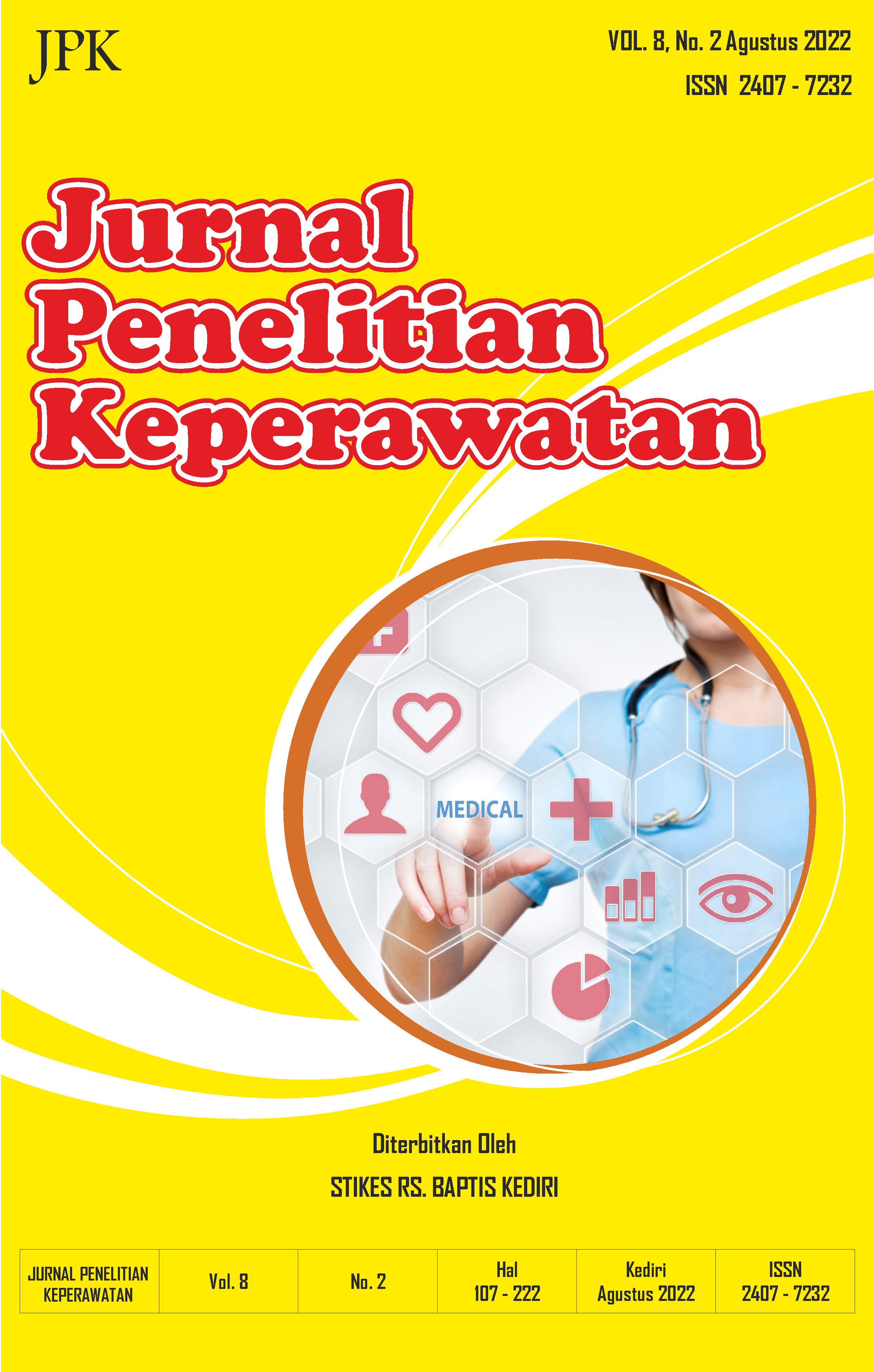AKTIVITAS FISIK DAN TINGKAT DEPRESI TERHADAP KADAR GULA DARAH PENDERITA DIABETES MELITUS TIPE 2
Abstract
Gangguan dalam metabolisme karbohidrat, lemak dan protein serta kondisi hiperglikemia berat yang merupakan karakteristik dari penyakit diabetes melitus.Beberapa faktor risiko DM tipe 2 meliputi genetik dan gaya hidup. Gaya hidup inilah yang menjadi pemicu utama penyakit DM meliputi kurang aktivitas, dan depresi. Tujuan penelitian diketahuinya hubungan antara aktivitas fisik dan tingkat depresi terhadap kadar gula darah penderita DM tipe 2. Penelitian korelasi dengan desain analitik deskriptif melalui pendekatan cross sectional. Populasi sebamyak 162 responden dan sampel berjumlah 116 orang yang dipilih dengan menggunakan teknik purposive. Proses pengambilan data dilakukan melalui lembar kuesioner Depression Anxiety Stress Scale (DASS) dan The International Physical Activity Questionnaire (IPAQ) serta lembar observasi kadar gula darah. Uji rank spearmanmerupakan uji statistik yang digunakan. Adanya hubungan aktivitas fisik dan tingkat depresi dengan kadar glukosa darah (dengan nilai p <0,05) dengan tingkat keeratan antara 2 variabel menunjukkan hubungan yang kuat. Penggunaan glukosa akan meningkat dengan melakukan akitivitas fisik secara rutin dan kondisi depresi sebaiknya dihindari oleh penderita diabetes karena depresi dapat memicu produksi hormon hormon yang dapatmenimbulkan peningkatan gula darah dan kondisi hiperglikemia kronik.
References
Almetwazi, M., Alwhaibi, M., Balkhi, B., Almohaini, H., Alturki, H., Alhawassi, T., Ata, S., AlQahtani, N., Mahmoud, M., & Alshammari, T. (2019). Factors associated with glycemic control in type 2 diabetic patients in Saudi Arabia. Saudi Pharmaceutical Journal, 27(3), 384–388. https://doi.org/10.1016/j.jsps.2018.12.007
Amelia, R., Lelo, A., Lindarto, D., & Mutiara, E. (2018). Analysis of factors affecting the self-care behaviors of diabetes mellitus type 2 patients in Binjai, North Sumatera-Indonesia. Asian Journal of Microbiology, Biotechnology and Environmental Sciences, 20(2), 361–367.
Burholt, V., & Scharf, T. (2014). Poor health and loneliness in later life: The role of depressive symptoms, social resources, and rural environments. Journals of Gerontology - Series B Psychological Sciences and Social Sciences, 69(2), 311–324. https://doi.org/10.1093/geronb/gbt121
Chaudhary, N., & Tyagi, N. (2018). Diabetes mellitus: An Overview. International Journal of Research and Development in Pharmacy & Life Sciences, 7(4), 3030–3033. https://doi.org/10.21276/ijrdpl.2278-0238.2018.7(4).3030-3033
De La Roca-Chiapas, J. M., Hernández-González, M., Candelario, M., Villafaña, M. D. L. L., Hernández, E., Solorio, S., Rivera, A. E., Sosa, M., & Jasso, J. A. (2013). Association between depression and higher glucose levels in middle-aged Mexican patients with diabetes. Revista de Investigacion Clinica, 65(3), 209–213.
Dorothea Büchtemann, Melanie Luppa, A., & Bramesfeld, S. R.-H. (2012). Incidence of late-life depression: A systematic review. 142(1–3), 172–179. https://doi.org/https://doi.org/10.1016/j.jad.2012.05.010
Ginszt, A., Ginszt, M., Majcher, P., & Tarkowski, Z. (2018). Effects of exercise on blood glucose levels in type 2 diabetic patients – Literature review. Polish Annals of Medicine, 25(2), 272–276. https://doi.org/10.29089/2017.17.00037
Islam, M. R. (2017). Association between Socio-Demographic Factors and Blood Sugar Levels in Type 2 Diabetes Mellitus Patients in Bangladesh. Journal of Diabetes Mellitus, 07(03), 151–159. https://doi.org/10.4236/jdm.2017.73012
Krishna, P. (2018). Depression, anxiety, and stress levels in patients with type 2 diabetes mellitus. National Journal of Physiology, Pharmacy and Pharmacology, 8(9), 1570. https://doi.org/10.5455/njppp.2018.8.0929117092018
Marín-Peñalver, J. J., Martín-Timón, I., Sevillano-Collantes, C., & Cañizo-Gómez, F. J. del. (2016). Update on the treatment of type 2 diabetes mellitus. World Journal of Diabetes, 7(17), 354. https://doi.org/10.4239/wjd.v7.i17.354
Nanayakkara, N., Pease, A., Ranasinha, S., Wischer, N., Andrikopoulos, S., Speight, J., De Courten, B., & Zoungas, S. (2018). Depression and diabetes distress in adults with type 2 diabetes: Results from the Australian National Diabetes Audit (ANDA) 2016. Scientific Reports, 8(1), 1–10. https://doi.org/10.1038/s41598-018-26138-5
Nugroho, Septyan Adi; Purwanti, O. S. (2013). Hubungan Antara Tingkat Stres Dengan Kadar Darah Pada Pasien Diabetes Melitus Di Wilayah Kerja Puskesmas Sukoharjo I Kabupaten Sukoharjo. Hubungan Antara Tingkat Stres Dengan Kadar Gula Darah Pada Pasien Diabetes Melitus Di Wilayah Kerja Puskesmas Sukoharjo I Kabupaten Sukoharjo, 43–51.
Pang, G. M., Li, F. X., Yan, Y., Zhang, Y., Kong, L. L., Zhu, P., Wang, K. F., Zhang, F., Liu, B., & Lu, C. (2019). Herbal medicine in the treatment of patients with type 2 diabetes mellitus. Chinese Medical Journal, 132(1), 78–85. https://doi.org/10.1097/CM9.0000000000000006
Putri, M., Persariningrat, R. T. I., Surialaga, S., & Syamsunarno, M. rizky A. A. (2019). Physical Activities Decrease Fasting Blood Glucose Level in Diabetes Mellitus Type 2 Patients: Use of International Physical Activity Questionnaire (IPAQ) in Rural Area. Majalah Kedokteran Bandung, 51(4), 201–205. https://doi.org/10.15395/mkb.v51n4.1765
Sigal, R. J., Armstrong, M. J., Bacon, S. L., Boulé, N. G., Dasgupta, K., Kenny, G. P., & Riddell, M. C. (2018). Physical Activity and Diabetes. Canadian Journal of Diabetes, 42, S54–S63. https://doi.org/10.1016/j.jcjd.2017.10.008
Sigal, R. J., Armstrong, M. J., Colby, P., Kenny, G. P., Plotnikoff, R. C., Reichert, S. M., & Riddell, M. C. (2013). Physical Activity and Diabetes. Canadian Journal of Diabetes, 37(SUPPL.1), S40–S44. https://doi.org/10.1016/j.jcjd.2013.01.018
Sunny, A. K., Khanal, V. K., Sah, R. B., & Ghimire, A. (2019). Depression among people living with type 2 diabetes in an urbanizing community of Nepal. PLoS ONE, 14(6), 1–11. https://doi.org/10.1371/journal.pone.0218119
Thrasher, J. (2017). Pharmacologic Management of Type 2 Diabetes Mellitus: Available Therapies. American Journal of Cardiology, 120(1), S4–S16. https://doi.org/10.1016/j.amjcard.2017.05.009
Wu, Y., Ding, Y., Tanaka, Y., & Zhang, W. (2014). Risk factors contributing to type 2 diabetes and recent advances in the treatment and prevention. International Journal of Medical Sciences, 11(11), 1185–1200. https://doi.org/10.7150/ijms.10001
Yang, D., Yang, Y., Li, Y., & Han, R. (2019). Physical Exercise as Therapy for Type 2 Diabetes Mellitus: From Mechanism to Orientation. Annals of Nutrition and Metabolism, 74(4), 313–321. https://doi.org/10.1159/000500110
Zheng, X., Qi, Y., Bi, L., Shi, W., Zhang, Y., Zhao, D., Hu, S., Li, M., & Li, Q. (2020). Effects of Exercise on Blood Glucose and Glycemic Variability in Type 2 Diabetic Patients with Dawn Phenomenon. BioMed Research International, 2020. https://doi.org/10.1155/2020/6408724
Copyright (c) 2022 Anita Dwi Ariyani, Maulana Ahmad Badaruddin (Array)

This work is licensed under a Creative Commons Attribution-ShareAlike 4.0 International License.




